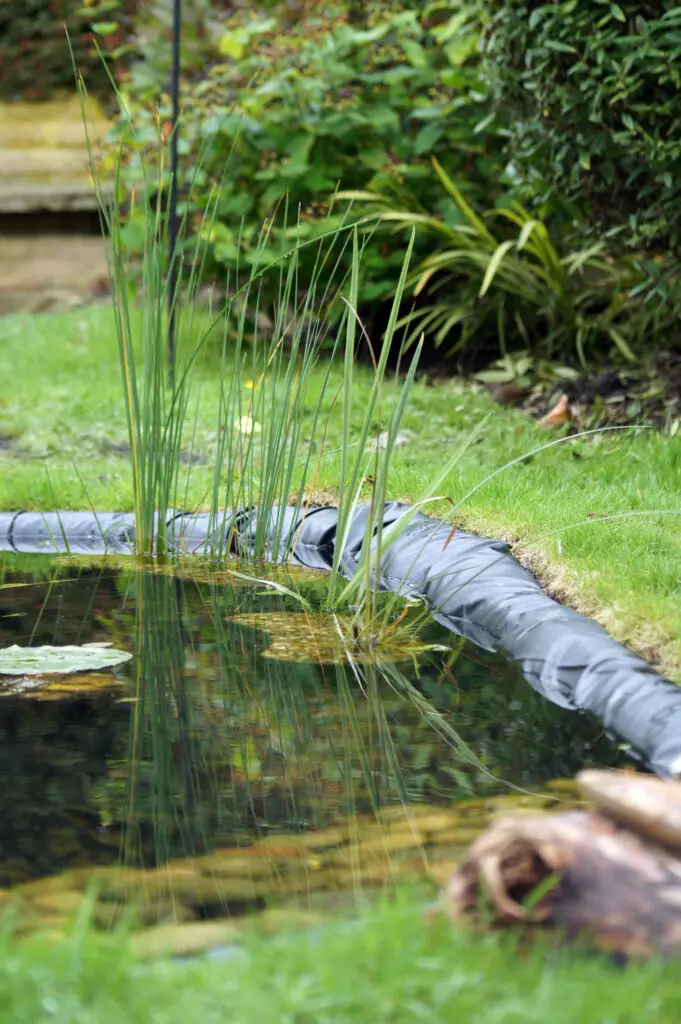
Pond liners not only serve a key functional purpose in a pond, but they also have a huge impact on the pond’s overall aesthetic. Pond liners come in a few different types of materials in different colors. When you are building a koi pond, it is very important to carefully consider the type of pond liner you use.
The most common color pond liner for koi ponds is black. It is almost invisible and hides debris and algae in the pond. Blue is the next most popular color. Blue is the best background color to view koi fish against. It enhances their colors. Pond liners also come in white, gray, and tan.
Each color of pond liner has its advantages and disadvantages. The color pond liner you choose will have a drastic effect on how your koi pond will look. The color of the pond liner can also affect the water quality. Here, we discuss all the different color pond liners to determine which color is best for your koi pond.
Pro Tip: If you’re tired of wasting money and making costly mistakes on the koi-keeping hobby or are thinking about buying koi fish but don’t know where to start, I strongly suggest you check out this ebook. I recently read this ebook, and it contains SO much useful information, such as:
- 3 proven steps to identify koi fish diseases
- WARNING: 3 things you should NEVER do when it comes to caring for koi
- When to seek professional help when it comes to looking after your koi
Why Are Koi Pond Liners Black?
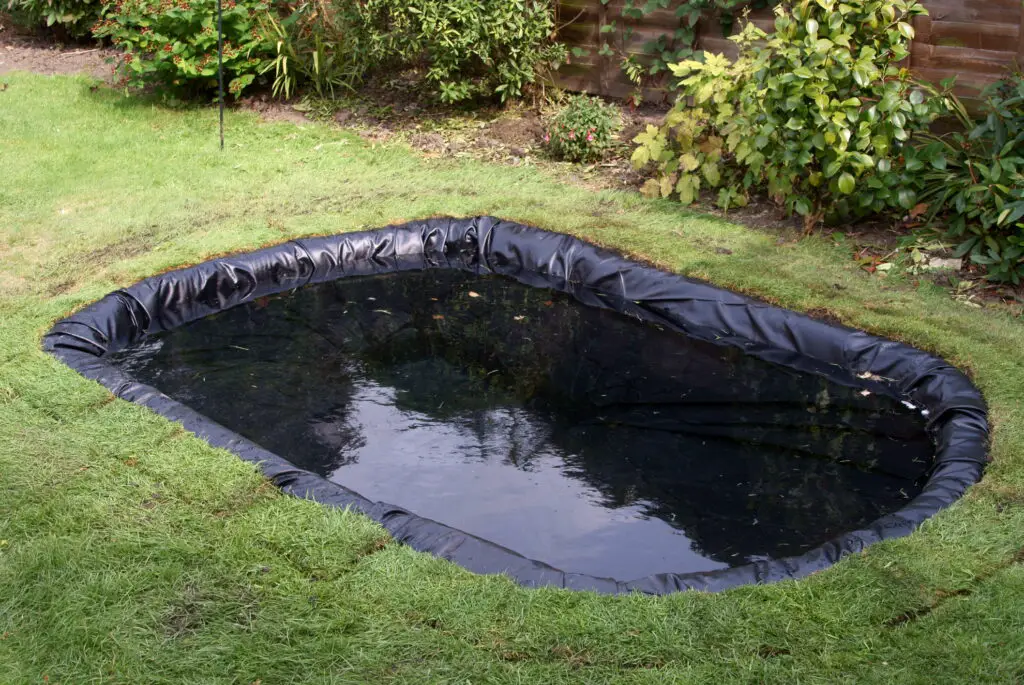
Black is definitely the most common color of pond liner. But just because it is the most common, does it mean it is necessarily the best color?
Colorful pond liners are more expensive than black ones. One of the reasons that black is such a popular color for pond liners is that it’s the cheapest color.
There are some noteworthy advantages to using a black pond liner:
- Black is a very neutral color for a pond liner. It looks good in a wide range of conditions in any pond. Black pond liners disappear underwater.
- Dirt and algal build-up on the pond liner do not show up on black. This keeps the pond looking cleaner and more beautiful.
- Koi fish display beautifully against a dark background.
However, in hot regions with year-round warm weather, black pond liners can be problematic. Black absorbs heat in the sun, and as the pond liner heats up, the water will warm up. In summer, the pond may get too hot for koi to tolerate!
Therefore, black is not always the best color pond liner.
What Color Pond Liner Is Best For A Koi Pond?
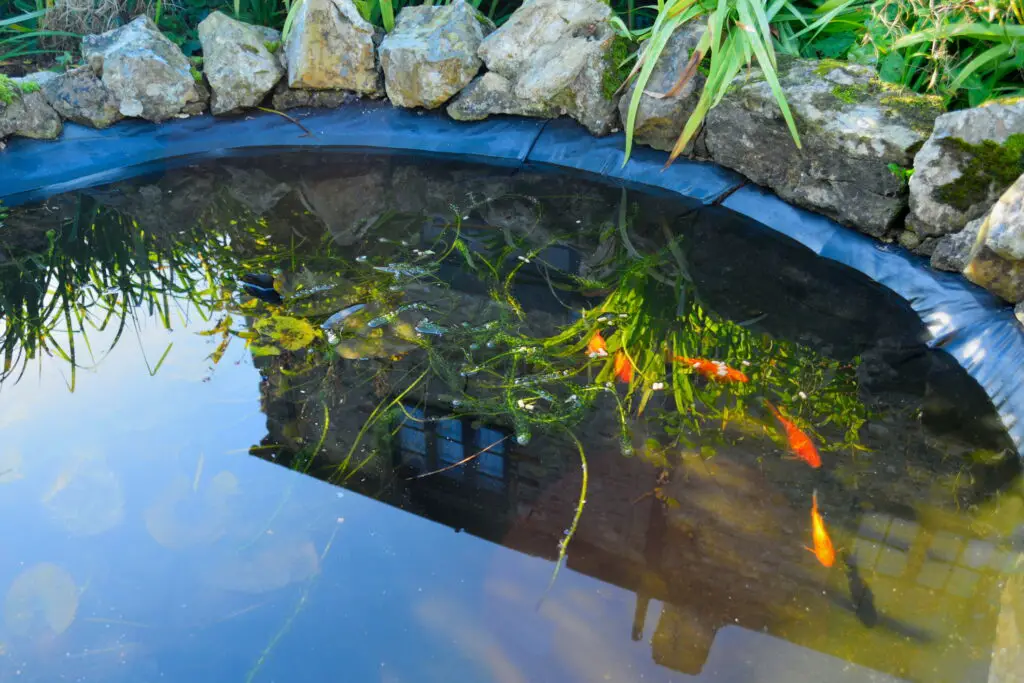
If you have ever watched a koi show, you would have seen that the fish are always displayed in a blue tub or tank. Blue is the second most popular color pond liner for koi ponds. Why is this the case?
Blue may be the best color pond liner for a koi pond because it does not absorb heat as black pond liners do. Blue pond liners are more suitable for ponds in warmer regions because they will not cause the water to overheat.
Koi fishes’ colors appear more vivid against a blue background. This is why show ponds and tanks are blue. It allows judges to view the fish in the best possible light.
If you want to see your koi fish in brilliant detail, a blue pond liner is an excellent choice. A blue pond liner will also make your koi pond’s water look clear and bright.
Gray And Tan Pond Liners Give A Natural Look

Gray and tan are great colors for a pond liner if you want your pond to look as natural as possible. These colors are very neutral, so the brightly colored koi fish and aquatic plants will look stunning against them.
Gray or tan pond liners help to keep a pond looking clean because dirt, algae, and debris do not show up clearly against these colors.
Tan or gray pond liners do not absorb as much heat as black pond liners. They do not have a drastic effect on the water temperature in the pond.
Be Wary Of White Pond Liners
A white pond liner can really make a koi pond stand out. However, every stain, bit of debris, and patch of algae will show up against a white pond liner. Unless you are very meticulous about cleaning your pond, a white pond liner can be a problem. It can make your pond look dirty all the time.
Because white reflects heat, a white pond liner will keep the water nice and cool during the hot summer months. It is a great choice for a pond liner if you live in a very hot region.
Factors To Consider When Deciding On A Pond Liner Color
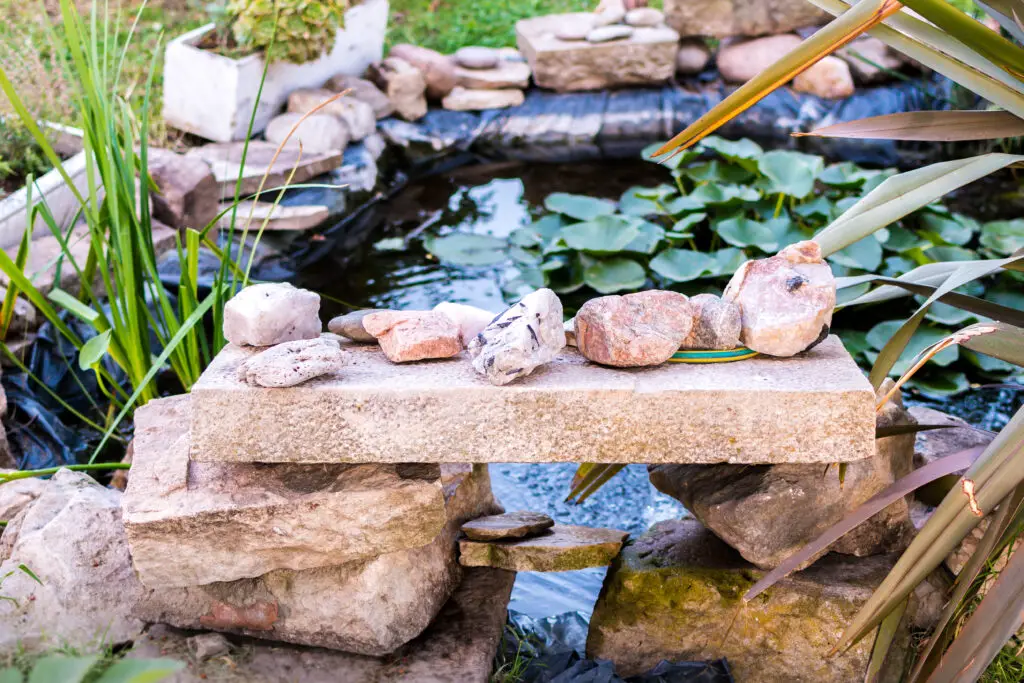
There is a wide range of colors to choose from when it comes to pond liners. Choosing a color can be quite daunting!
When deciding on the color for your pond liner, you need to think about the following:
- Your budget.
- The climate.
- Your desired aesthetic.
Black pond liners are the cheapest and most widely available option. You will have to pay more for blue, gray, tan, or white pond liners, and you may need to order these colors from your local hardware store.
Consider the climate where you live. Do summers get very hot, or are temperatures mild all year round? It is better to choose a lighter-colored pond liner if you live in a very hot region. Black is a good option if you live in a region where it does not often get hot.
A blue or white pond liner will make your koi pond stand out more. It will look brighter and slightly more manufactured. For the most neutral look, black, gray, or tan are the best options.
Which Type Of Pond Liner Is Best For A Koi Pond?
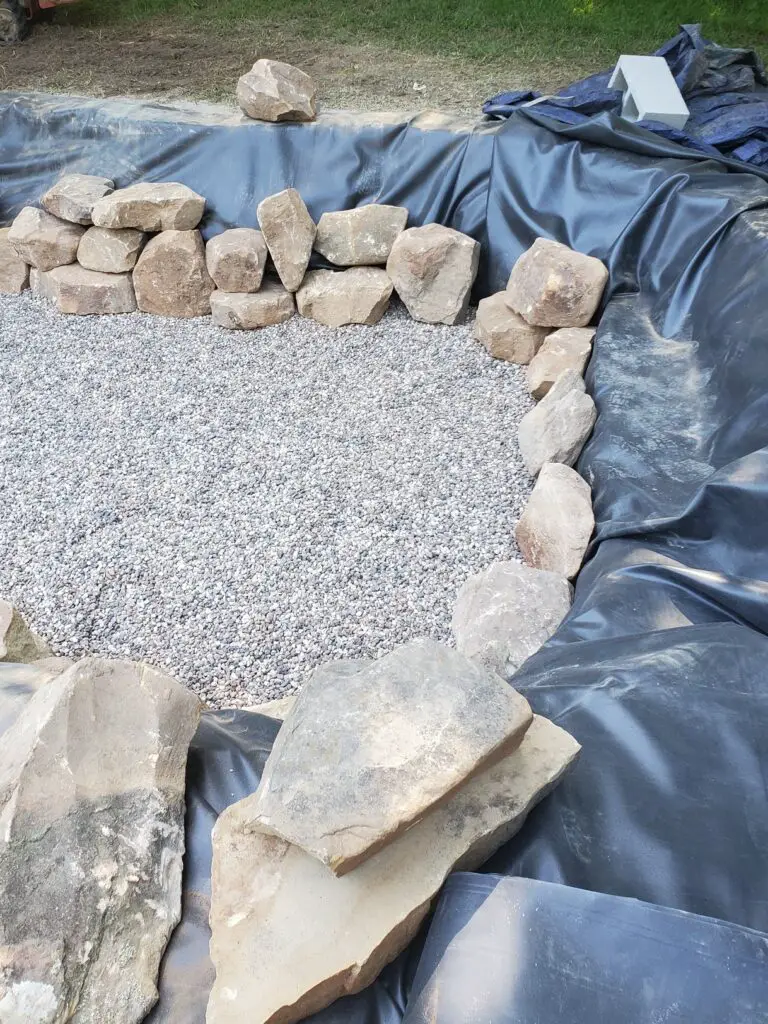
Apart from colors, pond liners also come in a range of different materials. What type of pond liner is the best choice for a koi pond?
PVC Pond Liners
PVC liner is the cheapest and most widely available option for a pond liner. It is 0.5mm thick, so it can rip quite easily during installation. But it is very easy to patch up, and two pieces of PVC liner can be taped together.
PVC pond liners are a good option for very small ponds. They are very flexible and easy to install.
A major drawback with PVC liner is that it is not always the safest for fish.
To make PVC into a flexible sheet, additives like plasticizers are added. These chemicals are toxic and can leach into pond water and harm fish. Fish-safe PVC liners are available, so look for a PVC pond liner that is specially made for fishponds.
PVC pond liners get brittle in cold temperatures. They can easily crack and split, especially if they are also exposed to sunlight.
HDPE Pond Liners
High-density polyethylene (HDPE) is a tough material that is UV resistant and stays durable in hot and cold temperatures. This is the type of geomembrane used in landfill sites to keep chemicals from seeping into the soil. HDPE is completely safe for fish.
HDPE is not very expensive. It costs around 60 cents per square foot. This makes it a cost-effective pond liner for large ponds.
A disadvantage of HDPE as a pond liner is that it is very stiff and heavy, making it difficult to install. It is impractical for small to medium-sized ponds with corners or steps. It can easily get stress fractures and scratches.
LLDPE Pond Liners
Linear low-density polyethylene (LLDPE) is similar to HDPE, but it is far more flexible. This makes LLDPE easier to work with and install into a pond. It can mold around corners and steps more neatly.
LLDPE costs roughly the same as HDPE, it is also safe for fish, and it functions well at a range of temperatures. One disadvantage is that LLDPE does not have good UV resistance, so it is not as durable if it is exposed to sunlight.
RPE Pond Liners
Reinforced polyethylene (RPE) is a strong and durable material to use as a pond liner. It has a lot of the same characteristics as HDPE and LLDPE, but it is much thinner and weighs less. This makes RPE easier and cheaper to transport or ship if you need large quantities.
RPE pond liners are safe for fish, and they are relatively UV resistant. These pond liners are more expensive than HDPE and LLDPE ones, but they are of slightly higher quality.
FFP Pond Liners
Flexible polypropylene (fPP) is a material that is very strong and flexible. It can easily mold to fit the shape of any pond, even ones with tight corners or nooks and crannies. The material is UV resistant and will not leach any chemicals into the water.
Pond liners made from fPP are more resistant to scratches, tears, and punctures. The material remains flexible, even in temperatures as low as -58°F. These pond liners are an excellent choice for ponds in regions with freezing winters.
EPDM Pond Liners
Ethylene propylene diene monomer (EPDM) rubber is commonly used for ponds. It has great flexibility, making it easy to install, and it is fish safe.
EPDM pond liners function well at extremely low and high temperatures. It will not get brittle and crack. EPDM is resistant to UV rays and is slow to weather.
Compared to other pond liner materials, EPDM is a bit pricier. It is also much heavier than other pond liners, so shipping a large quantity of EPDM can be very expensive.
Butyl Rubber Pond Liners
One of the most popular pond liners in the UK is butyl rubber. This synthetic rubber material is very durable and flexible. It is easy to install this type of pond liner as it wraps around tight corners neatly. Butyl rubber is safe for fish and does not get brittle in extreme temperatures.
Butyl rubber is resistant to weathering from UV rays, but it is quite vulnerable to punctures and tears. In the UK, butyl rubber is expensive to use for a pond liner, but the material is cheap in the US. Compared to other pond liners, it is relatively expensive.
How Thick Should A Pond Liner Be?
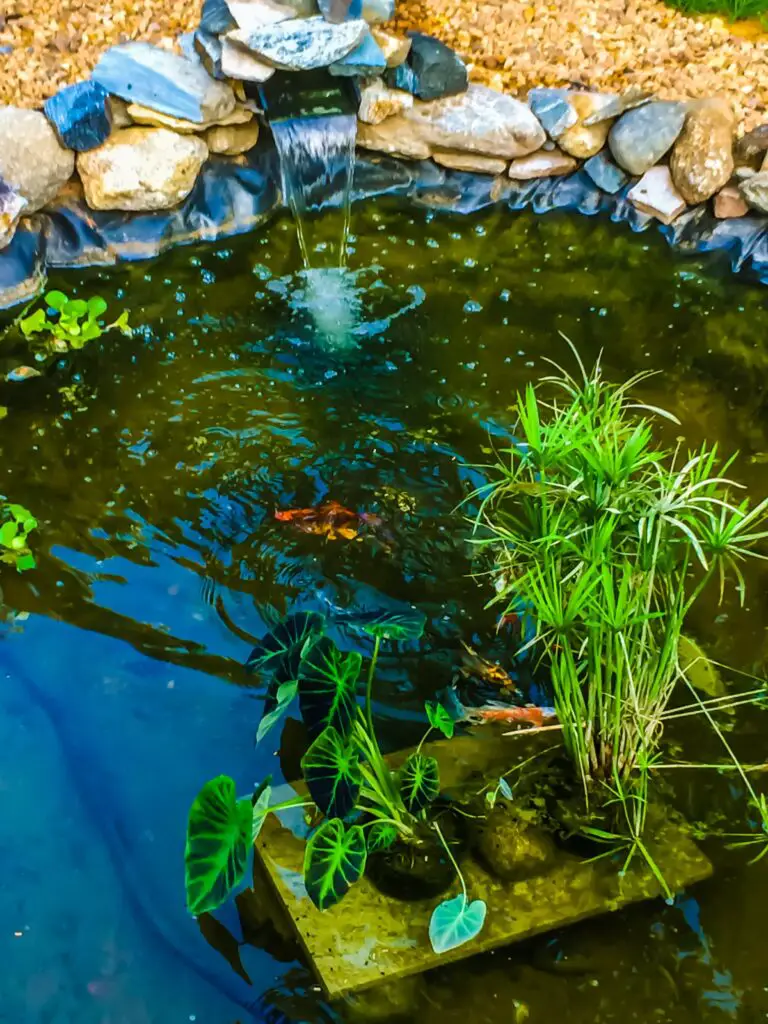

Different materials for pond liners vary in thickness from 0.12mm all the way to 2mm. But what is the ideal thickness you need for a pond liner?
A pond liner should be at least 0.5mm thick. The best thickness for a pond liner is 0.75mm. If you go too thick, the material becomes difficult to work with and install.
How Long Does A Pond Liner Last?
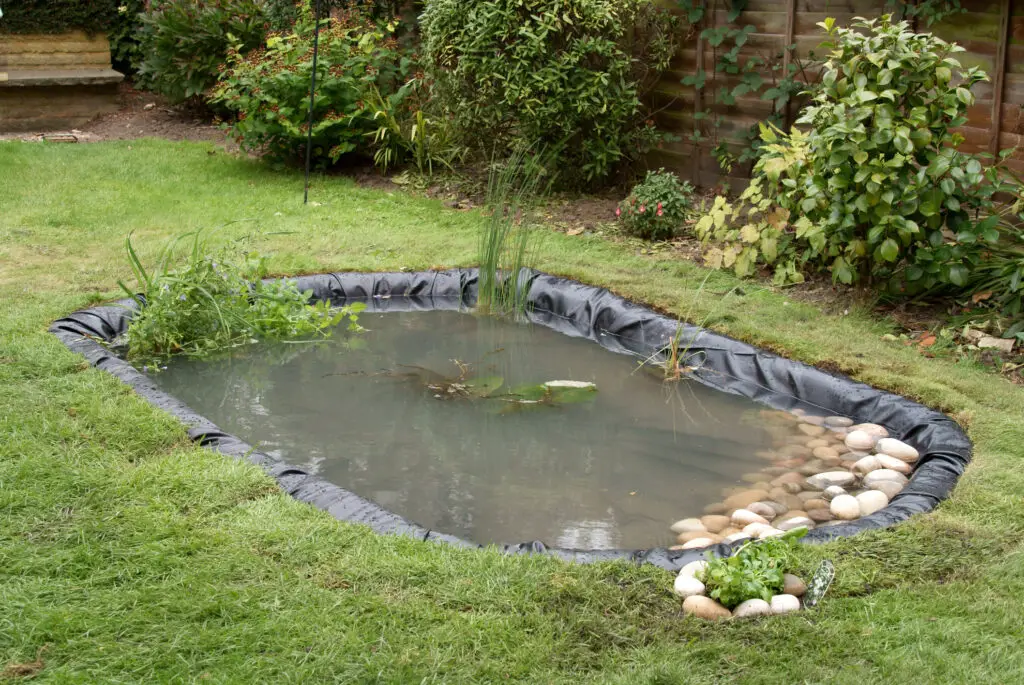
PVC liners are not very durable. They are not very resistant to UV rays, so if they are exposed to sunlight, they will quickly degrade in a year or two. To make a PVC liner last for 18 to 30 years, as it is intended to, it must be covered by at least 12 inches of sediment.
HDPE and LLDPE liners can last for 36 years if they are covered with sediment. They are resistant to UV radiation, so they will not degrade as quickly as PVC in the sun. LLDPE is less UV resistant than HDPE.
RPE pond liners will last for between 3 and 5 years if they are exposed to the sun. These pond liners can last 20 to 40 years if buried under sediment.
FPP pond liners can last for up to 30 years if they are covered with sediment. While fPP is resistant to UV rays, exposure to the sun will shorten its lifespan.
EPDM pond liners are extremely durable and UV resistant. Covered with a layer of sediment, they can last for 27 years or longer. UV exposure does shorten the lifespan of these pond liners.
Butyl rubber pond liners can last for up to 50 years if they are covered by a layer of sediment. UV exposure will shorten its lifespan.
Conclusion
The best color pond liners for koi ponds are black or blue. Black keeps the pond looking clean because algal growth and dirt do not show up against a black background. However, black pond liners can absorb heat and cause the water temperature to rise during summer. Blue pond liners have less impact on water temperature, and koi fish look particularly vivid against a blue background.
Resources
https://expertaquarist.com/different-colors-of-pond-liners/
https://modestfish.com/best-pond-liner/#What_to_Consider_Before_Buying_a_Pond_Liner
https://www.pondarmor.com/blue-fish-pond-liners-why-is-blue-fish-pond-liner-such-a-good-idea/


